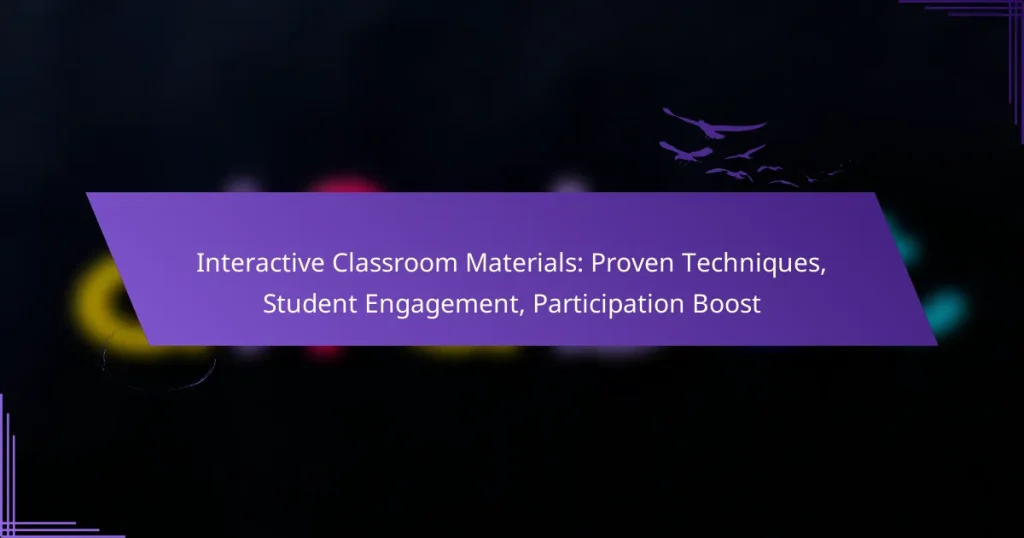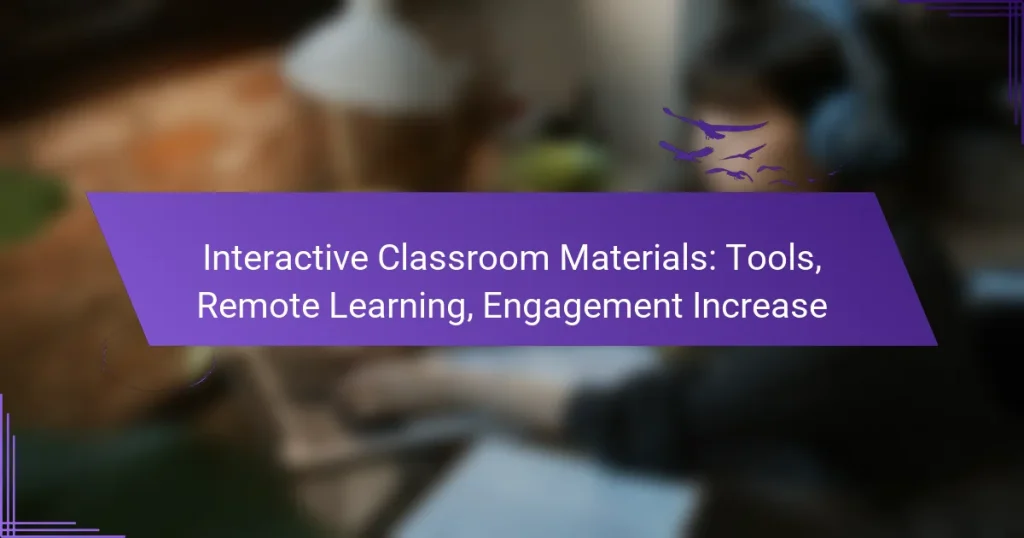Interactive classroom materials play a crucial role in enhancing student engagement by promoting active participation and enriching the overall learning experience. By utilizing tools such as live polls, quizzes, and collaborative projects, educators can foster a dynamic environment where students are motivated to interact with content and collaborate with their peers.
Interactive Classroom Materials: Proven Techniques, Student Engagement, Participation Boost
Interactive Classroom Materials: Engagement Strategies, Student Participation, Learning Environments
Interactive Classroom Materials: Engagement Metrics, Effectiveness Evaluation, Student Feedback
Interactive Classroom Materials: Gamification, Engagement Enhancement, Student Experience
Interactive Classroom Materials: Tools, Remote Learning, Engagement Increase
Interactive Classroom Materials: Special Needs Engagement, Student Interaction
How can interactive classroom materials enhance student engagement?
Interactive classroom materials significantly boost student engagement by fostering active participation and enhancing the learning experience. These tools encourage students to interact with content, collaborate with peers, and apply their knowledge in practical ways.
Increased participation through gamification
Gamification incorporates game-like elements into learning activities, making lessons more engaging and enjoyable. Techniques such as point systems, leaderboards, and rewards can motivate students to participate actively and compete in a friendly manner.
For example, using a quiz platform that allows students to earn points for correct answers can transform a traditional review session into an exciting competition. This approach not only increases participation but also encourages students to take risks and learn from their mistakes.
Improved retention with multimedia resources
Multimedia resources, such as videos, interactive simulations, and infographics, cater to different learning styles and help reinforce concepts. By presenting information in various formats, these materials can enhance understanding and retention of complex topics.
For instance, a science lesson that combines video demonstrations with hands-on experiments can help students grasp difficult concepts more effectively. Incorporating these resources into lessons can lead to better long-term retention and a deeper understanding of the subject matter.
What are effective engagement techniques for online courses?
Effective engagement techniques for online courses include interactive methods that foster participation and collaboration among students. Utilizing tools like live polls, quizzes, and collaborative projects can significantly enhance the learning experience and keep students motivated.
Live polls and quizzes
Live polls and quizzes are powerful tools for gauging student understanding in real-time. By incorporating these elements into your online courses, you can create a dynamic learning environment where students feel involved and valued. Consider using platforms like Kahoot or Mentimeter, which allow for instant feedback and can be easily integrated into your sessions.
When designing polls and quizzes, aim for a mix of question types, such as multiple choice, true/false, and open-ended questions. This variety keeps students engaged and caters to different learning styles. Remember to share results immediately to spark discussion and reinforce learning.
Collaborative projects using Google Workspace
Collaborative projects using Google Workspace can enhance teamwork and communication among students. Tools like Google Docs, Sheets, and Slides allow multiple users to work simultaneously, making it easy to collaborate on assignments and presentations. This approach not only helps students learn from each other but also builds essential skills for the workplace.
To implement collaborative projects effectively, set clear objectives and guidelines. Encourage students to divide tasks based on their strengths and establish deadlines to maintain momentum. Regular check-ins can help ensure that all group members are contributing and staying on track. Consider using Google Meet for virtual meetings to facilitate discussions and brainstorming sessions.
Which tools support interactive classroom materials?
Several tools enhance interactive classroom materials by promoting student engagement and participation. These platforms allow educators to create quizzes, interactive lessons, and collaborative activities that cater to diverse learning styles.
Kahoot for quizzes
Kahoot is a game-based learning platform that allows teachers to create quizzes that students can answer in real-time. This tool fosters competition and excitement, making learning fun while providing instant feedback on student performance.
To use Kahoot effectively, educators should design quizzes that are concise and focused on key learning objectives. Incorporating multimedia elements like images and videos can enhance the experience. Avoid overly complex questions to maintain engagement and ensure clarity.
Nearpod for interactive lessons
Nearpod is an interactive lesson delivery tool that enables teachers to present content in a dynamic way. It allows for real-time assessments, polls, and collaborative activities, making lessons more engaging for students.
When using Nearpod, teachers can create lessons that include interactive slides, videos, and quizzes. It’s beneficial to integrate formative assessments throughout the lesson to gauge understanding. Be mindful of pacing; too many interactive elements can overwhelm students, so balance is key.
How do teachers implement engagement strategies?
Teachers implement engagement strategies by actively involving students in the learning process through various interactive techniques. These methods foster participation, enhance understanding, and create a more dynamic classroom environment.
Incorporating student feedback
Incorporating student feedback is essential for tailoring engagement strategies to meet learners’ needs. Teachers can use surveys, suggestion boxes, or informal discussions to gather insights on what students enjoy or find challenging.
To effectively implement this, consider scheduling regular feedback sessions, perhaps at the end of each unit. This allows students to express their thoughts on the materials and teaching methods, enabling adjustments that can improve overall engagement.
Utilizing breakout rooms for discussions
Utilizing breakout rooms for discussions encourages collaboration and deeper engagement among students. By dividing the class into smaller groups, teachers can facilitate focused conversations that allow all students to participate actively.
When setting up breakout rooms, provide clear guidelines and specific topics for discussion. Aim for groups of 3-5 students to ensure everyone has a chance to contribute. After the discussions, reconvene as a whole class to share insights, which reinforces learning and builds community.
What are the benefits of using interactive materials in education?
Interactive materials in education enhance student engagement, improve retention, and foster deeper understanding of concepts. By incorporating these resources, educators can create dynamic learning environments that cater to diverse learning styles.
Enhanced critical thinking skills
Using interactive materials encourages students to analyze, evaluate, and synthesize information, which are key components of critical thinking. Activities such as problem-solving tasks, simulations, and collaborative projects prompt learners to think independently and make informed decisions.
For instance, a classroom might use a digital simulation to explore environmental science, allowing students to manipulate variables and observe outcomes. This hands-on approach not only reinforces theoretical knowledge but also cultivates analytical skills that are essential in real-world scenarios.
Fostering a sense of community
Interactive materials promote collaboration and communication among students, helping to build a sense of community within the classroom. Group activities, discussions, and peer feedback create opportunities for students to connect and share diverse perspectives.
For example, using interactive platforms for group projects allows students to work together, regardless of their physical location. This not only strengthens relationships but also encourages a supportive learning atmosphere where students feel valued and engaged.
What criteria should be considered when selecting interactive materials?
When selecting interactive materials, consider their alignment with educational goals, accessibility for all learners, and the engagement level they offer. These criteria ensure that the materials not only enhance learning but also cater to the diverse needs of students.
Alignment with learning objectives
Interactive materials should directly support the specific learning objectives of the course or lesson. This alignment ensures that students are not only engaged but also achieving the intended educational outcomes. For example, if the goal is to improve critical thinking, materials that promote problem-solving and analysis should be prioritized.
To evaluate alignment, review the curriculum standards and match them with the features of the materials. A checklist can help: does the material encourage collaboration, critical thinking, or creativity? If it does, it likely aligns well with your objectives.
Accessibility for diverse learners
Accessibility is crucial when selecting interactive materials, as they must be usable by all students, including those with disabilities. Consider materials that offer multiple means of engagement, representation, and action. For instance, materials that provide text-to-speech options or adjustable font sizes can significantly enhance accessibility.
Additionally, ensure that the materials comply with relevant accessibility standards, such as the Web Content Accessibility Guidelines (WCAG). This compliance not only supports learners with disabilities but also benefits all students by creating a more inclusive learning environment.
What are emerging trends in interactive classroom materials?
Emerging trends in interactive classroom materials focus on enhancing student engagement through technology and innovative teaching methods. These materials often incorporate digital tools, gamification, and collaborative platforms to create immersive learning experiences.
Augmented reality applications
Augmented reality (AR) applications are transforming how students interact with educational content by overlaying digital information onto the real world. This technology enables learners to visualize complex concepts, such as anatomy or historical events, in a more engaging way.
When implementing AR in the classroom, consider the necessary devices and software. Many AR applications are compatible with smartphones and tablets, making them accessible for various educational settings. Examples include apps that allow students to explore 3D models of the solar system or historical landmarks through their devices.
To maximize the effectiveness of AR, ensure that the content aligns with curriculum objectives and encourages active participation. Avoid overloading students with too much information at once; instead, focus on specific learning outcomes and facilitate discussions around the AR experiences. This approach can lead to deeper understanding and retention of the material.






